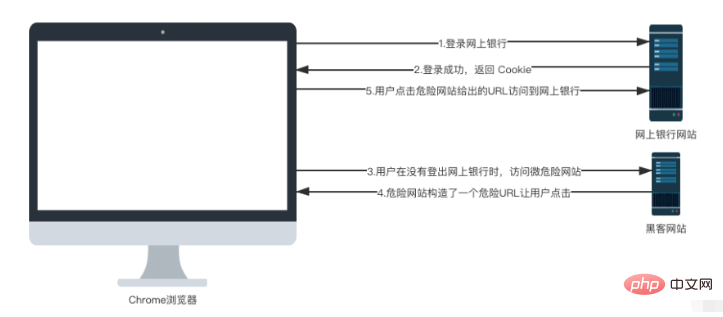CSRF 공격을 방어하려면 먼저 CSRF 공격이 무엇인지 이해해야 합니다. 다음 그림을 통해 CSRF 공격 프로세스를 정리하겠습니다.

사실 이 프로세스는 매우 간단합니다:
1. 사용자가 China Merchants Online Banking 웹사이트로 이동하여 로그인한다고 가정합니다.
2. 로그인이 성공하면 온라인 뱅킹은 쿠키를 프런트 엔드로 반환하고 브라우저는 쿠키를 저장합니다.
3. 사용자는 온라인 뱅킹에서 로그아웃하지 않고 브라우저에서 새 탭을 연 후 위험한 웹 사이트를 방문했습니다.
4. 이 위험한 웹사이트에는 하이퍼링크가 있고, 하이퍼링크의 주소는 China Merchants Online Banking을 가리킵니다.
4. 사용자가 이 링크를 클릭하면 브라우저에 저장된 쿠키가 자동으로 전달되므로 사용자가 자신도 모르게 온라인 뱅킹에 접속하여 손해를 입을 수 있습니다.
CSRF의 프로세스는 대략 이렇습니다. 다음으로 간단한 예를 사용하여 CSRF가 무엇인지 보여드리겠습니다.
1. 저는 csrf-mry라는 이름의 Spring Boot 프로젝트를 만들었습니다. 이 프로젝트는 위에서 언급한 온라인 뱅킹 웹사이트와 동일하며, 다음과 같이 웹 및 Spring 보안 종속성을 도입했습니다.
2 생성이 성공한 후 편의를 위해 application.properties 파일에서 Spring Security 사용자 이름/비밀번호를 직접 구성합니다.<dependencies> <dependency> <groupId>org.springframework.boot</groupId> <artifactId>spring-boot-starter-security</artifactId> </dependency> <dependency> <groupId>org.springframework.boot</groupId> <artifactId>spring-boot-starter-web</artifactId> </dependency> </dependencies>
server.port= 8866 spring.security.user.name=javaboy spring.security.user.password=123
package com.mry.csrf.controller;
import org.springframework.web.bind.annotation.GetMapping;
import org.springframework.web.bind.annotation.PostMapping;
import org.springframework.web.bind.annotation.RestController;
@RestController
public class CsrfDemoController {
@PostMapping("/transfer")
public void transferMoney(String name, Integer money) {
System.out.println("name = " + name);
System.out.println("money = " + money);
}
@GetMapping("/hello")
public String hello() {
return "hello";
}
}프로젝트가 성공적으로 생성된 후 먼저 프로젝트 포트를 수정합니다:
package com.mry.csrf.config;
import org.springframework.context.annotation.Configuration;
import org.springframework.security.config.annotation.web.builders.HttpSecurity;
import org.springframework.security.config.annotation.web.configuration.WebSecurityConfigurerAdapter;
@Configuration
public class SecurityConfig extends WebSecurityConfigurerAdapter {
@Override
protected void configure(HttpSecurity http) throws Exception {
http.authorizeRequests().anyRequest().authenticated()
.and()
.formLogin()
.and()
.csrf()
.disable();
}
}server.port= 8855
먼저 새로운 Spring Boot 프로젝트를 생성하고 이를 생성할 때 Spring Security, Thymeleaf 및 웹 종속성을 도입합니다.
<!DOCTYPE html>
<html lang="en">
<head>
<meta charset="UTF-8">
<title>Title</title>
</head>
<body>
<form action="http://localhost:8866/transfer" method="post">
<input type="hidden" value="javaboy" name="name">
<input type="hidden" value="10000" name="money">
<input type="submit" value="点击查看美女图片">
</form>
</body>
</html><dependencies> <dependency> <groupId>org.springframework.boot</groupId> <artifactId>spring-boot-starter-web</artifactId> </dependency> <dependency> <groupId>org.springframework.boot</groupId> <artifactId>spring-boot-starter-security</artifactId> </dependency> <dependency> <groupId>org.springframework.boot</groupId> <artifactId>spring-boot-starter-thymeleaf</artifactId> </dependency> <dependency> <groupId>org.springframework.boot</groupId> <artifactId>spring-boot-starter-test</artifactId> <scope>test</scope> </dependency> </dependencies>
spring.security.user.name=mry spring.security.user.password=123456
package com.mry.csrf.controller;
import org.springframework.web.bind.annotation.PostMapping;
import org.springframework.web.bind.annotation.ResponseBody;
import org.springframework.web.bind.annotation.RestController;
@RestController
public class SecurityCsrfController {
@PostMapping("/hello")
@ResponseBody
public String hello() {
return "hello";
}
}<!DOCTYPE html>
<!--导入thymeleaf的名称空间-->
<html lang="en" xmlns:th="http://www.thymeleaf.org">
<head>
<meta charset="UTF-8">
<title>Title</title>
</head>
<body>
<form action="/hello" method="post">
<input type="hidden" th:value="${_csrf.token}" th:name="${_csrf.parameterName}">
<input type="submit" value="hello">
</form>
</body>
</html>
这里我们用了 Spring Security 的默认登录页面,如果大家使用自定义登录页面,可以参考上面 hello.html 的写法,通过一个隐藏域传递 _csrf 参数。
访问到 hello 页面之后,再去点击【hello】按钮,就可以访问到 hello 接口了。

这是 Spring Security 中默认的方案,通过 Model 将相关的数据带到前端来。
如果你的项目是前后端不分项目,这种方案就可以了,如果你的项目是前后端分离项目,这种方案很明显不够用。
如果是前后端分离项目,Spring Security 也提供了解决方案。
这次不是将 _csrf 放在 Model 中返回前端了,而是放在 Cookie 中返回前端,配置方式如下:
package com.mry.csrf.config;
import org.springframework.context.annotation.Configuration;
import org.springframework.security.config.annotation.web.builders.HttpSecurity;
import org.springframework.security.config.annotation.web.configuration.WebSecurityConfigurerAdapter;
import org.springframework.security.web.csrf.CookieCsrfTokenRepository;
@Configuration
public class SecurityConfig extends WebSecurityConfigurerAdapter {
@Override
protected void configure(HttpSecurity http) throws Exception {
http.authorizeRequests().anyRequest().authenticated()
.and()
.formLogin()
.and()
.csrf().csrfTokenRepository(CookieCsrfTokenRepository.withHttpOnlyFalse());
}
}有小伙伴可能会说放在 Cookie 中不是又被黑客网站盗用了吗?其实不会的,大家注意如下两个问题:
(1)黑客网站根本不知道你的 Cookie 里边存的啥,他也不需要知道,因为 CSRF 攻击是浏览器自动携带上 Cookie 中的数据的。
(2)我们将服务端生成的随机数放在 Cookie 中,前端需要从 Cookie 中自己提取出来 _csrf 参数,然后拼接成参数传递给后端,单纯的将 Cookie 中的数据传到服务端是没用的。
理解透了上面两点,你就会发现 _csrf 放在 Cookie 中是没有问题的,但是大家注意,配置的时候我们通过 withHttpOnlyFalse 方法获取了 CookieCsrfTokenRepository 的实例,该方法会设置 Cookie 中的 HttpOnly 属性为 false,也就是允许前端通过 js 操作 Cookie(否则你就没有办法获取到 _csrf)。
配置完成后,重启项目,此时我们就发现返回的 Cookie 中多了一项:

接下来,我们通过自定义登录页面,来看看前端要如何操作。
首先我们在 resources/static 目录下新建一个 html 页面叫做 login.html:
<!DOCTYPE html>
<html lang="en">
<head>
<meta charset="UTF-8">
<title>Title</title>
<script src="https://libs.baidu.com/jquery/2.1.4/jquery.min.js"></script>
<script src="https://cdn.bootcss.com/jquery-cookie/1.4.1/jquery.cookie.min.js"></script>
</head>
<body>
<div>
<input type="text" id="username">
<input type="password" id="password">
<input type="button" value="登录" id="loginBtn">
</div>
<script>
$("#loginBtn").click(function () {
let _csrf = $.cookie('XSRF-TOKEN');
$.post('/login.html',{username:$("#username").val(),password:$("#password").val(),_csrf:_csrf},function (data) {
alert(data);
})
})
</script>
</body>
</html>这段 html 给大家解释一下:
(1)首先引入 jquery 和 jquery.cookie ,方便我们一会操作 Cookie。
(2)定义三个 input,前两个是用户名和密码,第三个是登录按钮。
(3)点击登录按钮之后,我们先从 Cookie 中提取出 XSRF-TOKEN,这也就是我们要上传的 csrf 参数。
(4)通过一个 POST 请求执行登录操作,注意携带上 _csrf 参数。
服务端我们也稍作修改,如下:
package com.mry.csrf.config;
import org.springframework.context.annotation.Configuration;
import org.springframework.security.config.annotation.web.builders.HttpSecurity;
import org.springframework.security.config.annotation.web.builders.WebSecurity;
import org.springframework.security.config.annotation.web.configuration.WebSecurityConfigurerAdapter;
import org.springframework.security.web.csrf.CookieCsrfTokenRepository;
@Configuration
public class SecurityConfig extends WebSecurityConfigurerAdapter {
@Override
public void configure(WebSecurity web) throws Exception {
web.ignoring().antMatchers("/static/js/**");
}
@Override
protected void configure(HttpSecurity http) throws Exception {
http.authorizeRequests().anyRequest().authenticated()
.and()
.formLogin()
.loginPage("/login.html")
.successHandler((req,resp,authentication)->{
resp.getWriter().write("success");
})
.permitAll()
.and()
.csrf().csrfTokenRepository(CookieCsrfTokenRepository.withHttpOnlyFalse());
}
}一方面这里给 js 文件放行。
另一方面配置一下登录页面,以及登录成功的回调,这里简单期间,登录成功的回调我就给一个字符串就可以了。在登录成功后回调的详细解释。
OK,所有事情做完之后,我们访问 login.html 页面,输入用户名密码进行登录,结果如下:

可以看到,我们的 _csrf 配置已经生效了。
위 내용은 CSRF 공격에 대한 SpringBoot의 방어 프로세스와 원칙은 무엇입니까?의 상세 내용입니다. 자세한 내용은 PHP 중국어 웹사이트의 기타 관련 기사를 참조하세요!